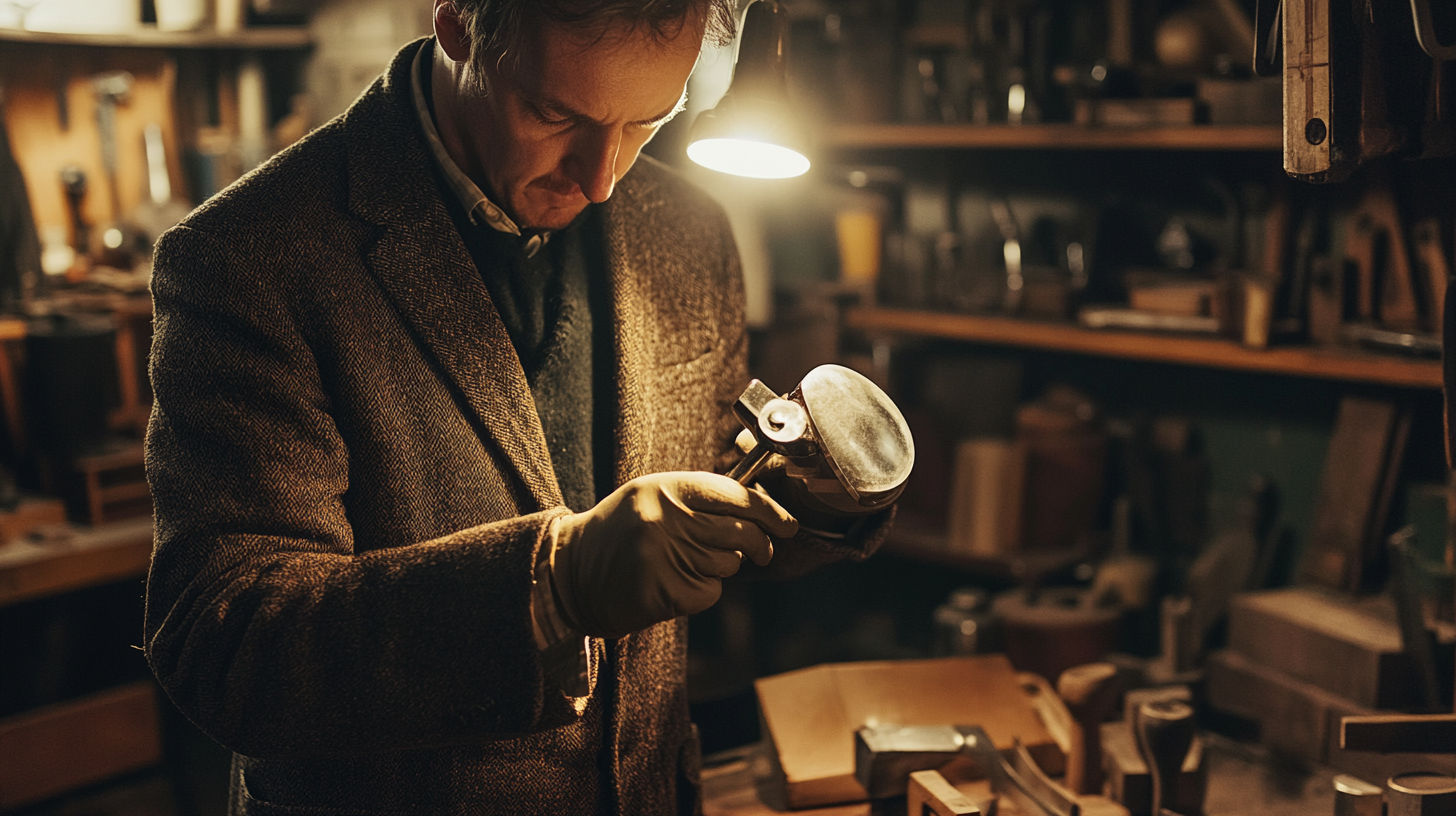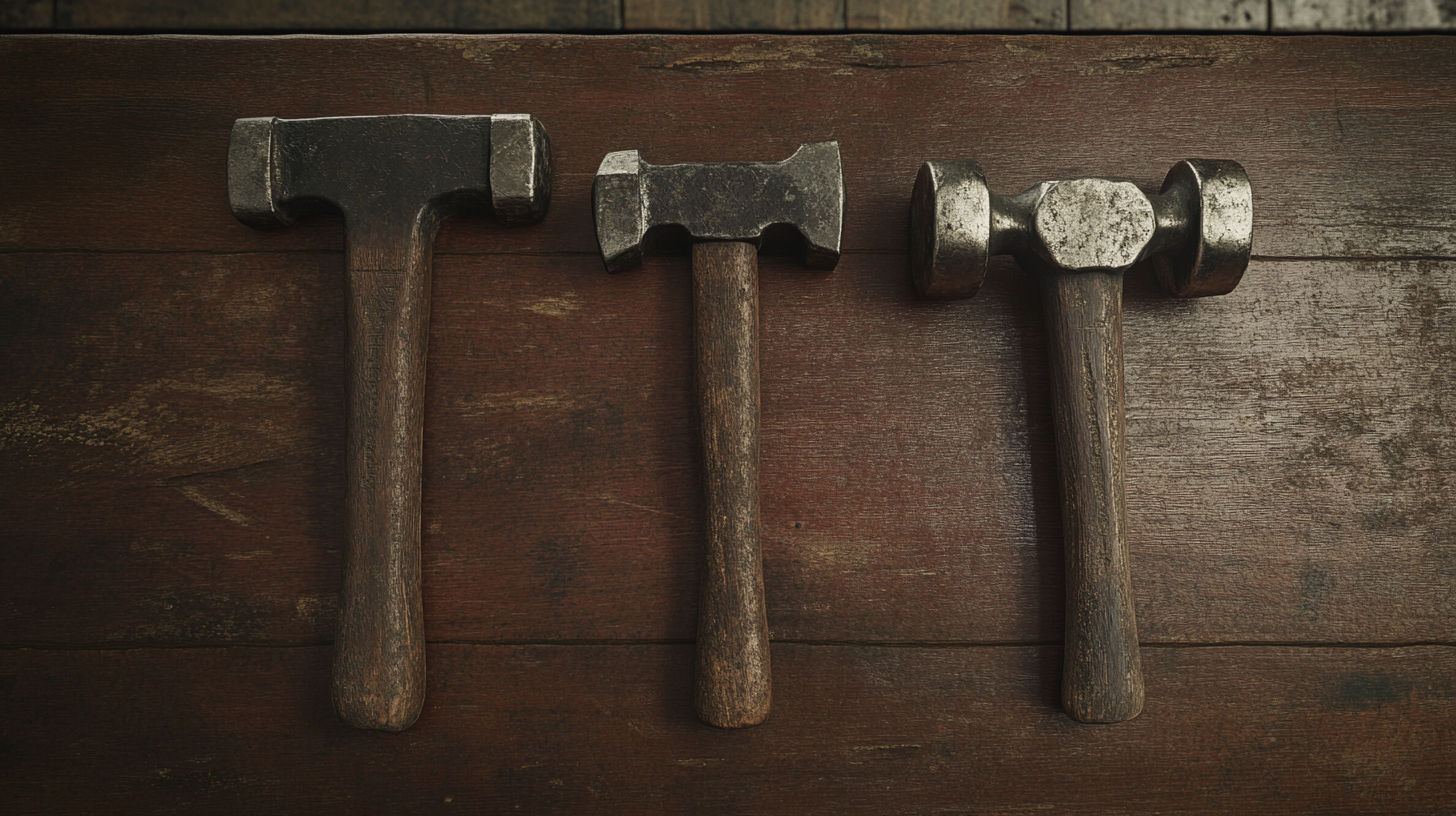Hammers are among the oldest and most essential tools in human history, with origins dating back over 3.3 million years. From primitive stone tools to specialized instruments crafted for specific trades, hammers reflect our technological evolution and cultural development. For collectors, historians, and craftspeople, antique hammers represent not just functional tools but valuable artifacts that connect us to our past.
In this comprehensive guide, we’ll explore the fascinating world of antique hammer identification, helping you understand the distinctive features, historical significance, and potential value of these enduring implements. Whether you’ve inherited an old hammer, discovered one at an estate sale, or are actively building a collection, this article will provide the expertise you need to identify, authenticate, and appreciate these historical treasures.
Understanding Antique Hammer Types and Their History
The Evolution of Hammers
The hammer stands as one of humanity’s earliest and most versatile tools. Archaeological evidence suggests that hammering tools date back to prehistoric times, with the earliest examples being simple stones used for crushing and pounding. As civilizations developed, so did hammer design.
Historical Timeline of Hammer Development
- 3.3 Million Years Ago
Earliest Stone Hammers
Simple stone hammers used by early hominids. Archaeological discoveries near Lake Turkana in Kenya revealed hammer stones dating to this period. - 3000 BCE
Copper and Bronze Age Hammers
Metal-headed hammers emerged, initially made from copper and later bronze, allowing for more durable and specialized designs. - 1500 BCE - 500 CE
Iron Age Innovations
Iron hammers became common, offering greater durability and specialized forms for specific trades. - Medieval Period
Trade Specialization
Distinct hammer types developed for specific trades: blacksmithing, cooperage, cobbling, and more. - Industrial Revolution
Mass Production
Factory-produced hammers became available in standardized designs, though many specialty hammers remained handcrafted. - 19th-20th Century
Modern Innovations
New materials and manufacturing techniques led to improvements in hammer design and durability, including the popular claw hammer.
Types of Antique Hammers
Antique hammers come in a remarkable variety of styles, each designed for specific tasks across different trades. Understanding these types is essential for proper identification:
Antique Hammer Diversity
Trade-Specific Hammers
Blacksmith Hammers
- Cross pein, straight pein, and sledge hammers
- Typically heavier with sturdy construction
- Often feature distinctive forge marks
Cobbler’s Hammers
- Small, compact design with a distinctive “waisted” shape
- Usually have a split head for different striking surfaces
- Used for leatherwork and shoe construction
Jeweler’s Hammers
- Delicate with precisely machined faces
- Often feature one rounded and one flat face
- Smaller size with elegant, balanced design
Carpenter’s Hammers
- Claw hammers for nail extraction
- Various types including framing hammers, finish hammers
- Often feature distinctive handle designs and head shapes
Cooper’s Hammers
- Used in barrel making
- Feature specialized shapes for working curved surfaces
- Often have extended or curved faces
Tinsmith’s Hammers
- Used for metalwork and tinsmithing
- Feature distinctive pein shapes for creating forms in metal
- Often smaller with precisely machined striking surfaces
Upholsterer’s Hammers
- Lightweight with magnetic heads for holding tacks
- Often feature claw or specialized extraction tools
- Compact design for detailed work
Geologist’s/Rock Hammers
- Feature a pointed pick on one side
- Flat face for striking
- Built for durability in field conditions
Antique Hammer Value Ranges
Current market values based on condition and rarity
</tbody>
</table>
Identifying Features of Antique Hammers
Key Identification Characteristics
When examining an antique hammer, pay close attention to these key identifying features:
Construction and Materials
The materials used in a hammer’s construction provide important clues about its age and authenticity:
Head Material
- Early hammers: Wrought iron with visible forge marks
- Later 19th century: Cast iron and steel
- Early 20th century: Drop-forged steel with more uniform appearance
Handle Material
- Hardwoods (hickory, ash, maple) were common
- Growth rings and patina indicate age
- Handcrafted vs. machine-turned profiles
- Pre-1860s handles often show hand-hewn characteristics
Head-to-Handle Attachment
- Eye shape (oval, round, teardrop)
- Wedge types (wooden, metal)
- Construction methods evolved over time
Maker’s Marks and Brand Identification
Manufacturer marks provide crucial information for identification and dating:
Where to Look for Maker's Marks
Check these areas when examining an antique hammer
- Side of hammer head
- Top or bottom of hammer face
- Near the eye where handle enters
- On the claw or pein section
- Stamped on the handle (less common)
Common historical hammer manufacturers include:
- Maydole - David Maydole’s hammers (started 1840s) were known for innovation and quality
- Plumb - The Plumb Company (established 1869) made premium hammers
- Stanley - Initially known for rules and levels before expanding to hammers
- Cheney - Specialized in hammers with distinctive designs
- Vaughan & Bushnell - Founded in 1869, known for quality and innovation
- Craftsman - Popular in the early-to-mid 20th century
- Whitehouse & Sons - British manufacturer of premium hammers
Many regional blacksmiths and toolmakers also produced hammers with distinctive local characteristics and marks.
Age-Related Characteristics
Several features can help you estimate a hammer’s age:
Patina and Wear Patterns
- Natural aging of metal produces distinct patination
- Handle wear reflects use patterns from specific trades
- Look for appropriate aging consistent with claimed age
Construction Methods
- Hand-forged vs. machine-forged characteristics
- Quality of casting or forging
- Refinement of design elements
Style and Form
- Hammer shapes evolved over time
- Functional elements (such as nail extraction slots) developed gradually
- Regional variations existed in different countries
Authentication and Valuation Methods
Determining Authenticity and Value
Authenticating antique hammers requires careful examination and comparison against known examples:
Authentication Process
Follow these steps to authenticate an antique hammer:
Visual Examination
- Look for appropriate wear patterns consistent with age
- Check for repairs, replacements, or modifications
- Examine patina for signs of artificial aging
Material Analysis
- Verify materials are period-appropriate
- Check for modern alloys or synthetic components
- Ensure wood species matches historical patterns
Construction Assessment
- Verify manufacturing techniques match the purported period
- Look for hand-forged characteristics in older examples
- Examine joinery methods between head and handle
Comparative Analysis
- Compare against known authenticated examples
- Check museums, reference books, and reputable collections
- Consult expert resources like the West Virginia University Vintage Hammers collection

Valuation Factors
The value of antique hammers depends on several key factors:
Rarity and Scarcity
- Uncommon trade hammers command premium prices
- Pre-industrial examples are particularly valuable
- Limited production models from known makers carry prestige
Historical Significance
- Hammers with documented historical use
- Examples from notable craftspeople or workshops
- Tools from significant historical periods or events
Condition Assessment
- Original components vs. replacements
- Functionality (whether still usable)
- State of preservation
Collector Demand
- Some types are more sought after than others
- Regional preferences affect market value
- Current collecting trends influence pricing
Notable Antique Hammer Auction Results
Recent sales of significant antique hammers
| Category | Price | Notes |
|---|---|---|
| Blacksmith Hammers | $50-$300+ | Higher for historical examples with maker's marks |
| Cobbler's Hammers | $40-$150 | Value increases with decorative elements and condition |
| Jeweler's Hammers | $30-$200 | Premium for precious metal details or high-end makers |
| Antique Claw Hammers | $20-$250 | Rarity and condition heavily impact value |
| Cooper's Hammers | $75-$400 | Increasingly rare and sought after by collectors |
| Pre-1850 Examples | $100-$1,000+ | Historical significance dramatically increases value |
</tbody>
</table>
Collecting and Preserving Antique Hammers
Building and Maintaining a Collection
For those interested in collecting antique hammers, follow these best practices:
Finding Antique Hammers
Successful collectors utilize multiple sources:
Estate Sales and Auctions
- Often yield high-quality, previously unknown examples
- Research provenance when possible
- Examine items carefully before bidding
Specialized Tool Dealers
- Offer authenticated items but at premium prices
- Can provide valuable expertise and documentation
- May offer guarantees of authenticity
Online Marketplaces
- Widest selection but varying reliability
- Request detailed photos and provenance information
- Check seller ratings and return policies
Collector Groups and Forums
- Connect with other collectors through forums like Reddit’s r/Vintagetools or Facebook’s Vintage Hammers group
- Attend tool collector meets and swap events
- Network with specialized collectors for trades and purchases
Conservation and Care
Proper preservation ensures your hammers maintain their value and historical integrity:
Cleaning Guidelines
- Gentle removal of loose dirt with soft brushes
- Avoid harsh chemicals that damage patina
- Minimal intervention preserves historical value
Storage Recommendations
- Climate-controlled environment (stable humidity)
- Individual storage to prevent damage
- Support heads and handles to prevent stress
Display Methods
- UV-filtered cases to prevent wood deterioration
- Secure mounting to prevent falls
- Interpretive labels to share historical context
Handling Best Practices
- Clean, dry hands or cotton gloves
- Support both head and handle when moving
- Limit unnecessary handling
Documentation Methods
Maintain comprehensive records for each item in your collection:
Acquisition Information
- Purchase date, source, and price
- Previous ownership history when available
- Any authentication documents or appraisals
Identification Details
- Precise measurements and weight
- Photos from multiple angles
- Close-ups of maker’s marks or distinctive features
Research Findings
- Historical context and usage
- Manufacturer information
- Comparable examples from museums or literature
Common Questions About Antique Hammer Identification
What are the different types of antique hammers?
Antique hammers come in numerous specialized types, each designed for specific trades and purposes:
- Stone sledge hammers used in quarrying and construction
- Cobbler hammers with distinctive waisted designs for leatherwork
- Ball peen hammers for metalworking
- Blacksmith hammers in various styles (cross pein, straight pein, sledge)
- Veneer hammers for fine woodworking
- Claw hammers for carpentry
- Jeweler’s hammers for delicate metalwork
- Cooper’s hammers for barrel making
- Tinsmith’s hammers for sheet metal work
- Upholsterer’s hammers for furniture making
Each type has distinctive features that reflect its specialized purpose, making identification possible through careful examination of head shape, weight, and overall design.
How can I determine how old my hammer is?
Dating an antique hammer involves examining several key factors:
- Construction method - hand-forged hammers (pre-1870s) show distinctive irregularities and forge marks
- Materials - early hammers used wrought iron, later ones used cast or drop-forged steel
- Head design - the shape and style of the head evolved over time
- Handle attachment - methods for securing the handle to the head changed over centuries
- Maker’s marks - if present, can help date the tool to a specific manufacturing period
- Patina and wear - natural aging produces characteristic wear patterns
For the most accurate dating, compare your hammer with dated examples in museum collections or reference books.
How can I identify the manufacturer of my antique hammer?
Identifying an antique hammer's manufacturer requires careful examination:
- Look for maker’s marks, logos, or stamps on the hammer head (commonly found on the side)
- Research any identified marks in reference books or online databases
- Compare the design characteristics with known examples from specific makers
- Consider regional manufacturing styles that might indicate origin
- Consult with experts or tool collectors who specialize in hammer identification
Some hammers have no maker’s marks, especially those made by local blacksmiths or small workshops. In these cases, regional characteristics and construction methods may provide clues about origin, though precise manufacturer identification may not be possible.
What makes an antique hammer valuable?
Several factors determine an antique hammer's value:
- Age - generally, older hammers (pre-1900) command higher prices
- Rarity - uncommon types or examples from lesser-known trades are more valuable
- Condition - original components, minimal damage, and working functionality increase value
- Provenance - documented history of ownership or use adds significant value
- Maker - hammers from prestigious or historically significant manufacturers are more desirable
- Historical significance - association with important events, periods, or people
- Aesthetic appeal - distinctive design, decorative elements, or craftsmanship quality
The collector market determines value, so prices can fluctuate based on current interests and trends in antique tool collecting.
How can I tell if a hammer is truly antique or just made to look old?
Authenticating an antique hammer requires examining several key indicators:
- Appropriate materials for the claimed period
- Construction methods consistent with historical techniques
- Natural patina and wear patterns (artificial aging often looks uniform)
- Weight and balance that reflects historical manufacturing capabilities
- Handle material with genuine age-related characteristics
- Period-consistent joinery methods between head and handle
Red flags for reproductions include:
- Modern alloys or materials not available in the claimed period
- Machine marks inconsistent with the purported age
- Artificially applied patina that doesn’t match natural aging patterns
- Overly uniform characteristics in supposedly hand-crafted elements
When in doubt, compare against authenticated museum examples or consult with experienced collectors or appraisers.
How should I clean and preserve my antique hammer?
Proper cleaning and preservation of antique hammers requires a conservative approach:For metal components:
- Remove loose dirt with soft brushes
- Lightly clean with mineral oil and a soft cloth
- Avoid harsh chemicals or abrasives that damage patina
- Apply a light coat of museum wax for protection (not modern oils)
For wooden handles:
- Dust with soft brushes
- Clean with minimal moisture (slightly damp cloth)
- Apply boiled linseed oil sparingly to prevent drying
- Avoid modern varnishes or polyurethanes
General preservation tips:
- Store in stable humidity and temperature
- Keep away from direct sunlight
- Support both head and handle to prevent stress
- Handle with clean, dry hands or cotton gloves
Remember that the goal is conservation, not restoration. Patina and signs of use are valuable aspects of antique tools and should be preserved rather than removed.
What's the difference between a framing hammer and a regular hammer?
Framing hammers differ from regular claw hammers in several key ways:
- Handle length - Framing hammers have longer handles (16-18 inches) compared to regular claw hammers (12-14 inches)
- Head weight - Framing hammers are heavier (20-32 oz) than regular claw hammers (16-20 oz)
- Face design - Framing hammers often have milled or waffle-pattern faces to prevent slipping when driving nails
- Claw shape - Framing hammers typically have straighter claws optimized for nail removal in construction
In antique examples, these distinctions may be less standardized than in modern tools, but the general principles of heavier weight and longer handle for framing work remain consistent historical characteristics.
Are there any apps or tools to help identify antique hammers?
While there isn't a specialized app exclusively for antique hammer identification, several resources can assist collectors:
General antique identification apps like:
- Google Lens (for visual matching)
- Magnifi+ (for detailed photography of maker’s marks)
- WorthPoint (for comparing against sold examples)
Online databases and resources:
- The International Tool Collectors Association database
- Museum collection databases (Smithsonian, etc.)
- Tool auction archives
Social media resources:
- Facebook groups dedicated to vintage tools
- Reddit communities like r/Tools and r/Vintagetools
- Instagram hashtags for antique tool identification
For most accurate identification, combining technology with reference books and expert consultation yields the best results. Tool collector forums can be particularly helpful, as members often have specialized knowledge about specific types of antique hammers.
Educational Resources and Further Learning
Expand Your Knowledge
For collectors looking to expand their knowledge, numerous resources are available:
Books and Publications
Several key publications offer detailed information on antique hammers:
- “Antique & Vintage Tools: A Guide to Pricing and Identification” by Ronald S. Barlow
- “Tools: Working Wood in Eighteenth-Century America” by James M. Gaynor
- “The Museum of Early American Tools” by Eric Sloane
- “The Chronicle” - Journal of the Early American Industries Association
- “Collecting Antique Tools” by Herbert P. Kean and Emil S. Pollak
Museum Collections
Notable museum collections featuring antique hammers include:
- The National Museum of American History (Smithsonian)
- Colonial Williamsburg Tool Collection
- The Museum of English Rural Life
- The West Virginia University Art in the Libraries Collection
- The Mercer Museum of the Bucks County Historical Society
Online Communities
Connect with fellow enthusiasts through these online communities:
External Resources for Antique Hammer Collectors
West Virginia University Vintage Hammers Exhibit
An excellent online exhibit featuring over 100 vintage hammers ranging from pre-colonial Native American hammer stones to specialized trade hammers used by jewelers, cobblers, and clockmakers.
Reddit r/Vintagetools Community
Active community of vintage tool enthusiasts who regularly help with hammer identification, share restoration techniques, and discuss collecting strategies.
Facebook Vintage Hammers Group
Dedicated group for enthusiasts focused specifically on antique and vintage hammers of all shapes, types, and sizes. Excellent resource for comparative identification.
Brown Tool Auctions
Video resource showcasing antique hammer types from the 59th International Antique Tool Auction, providing visual references for identifying various hammer styles.
Tooltique Vintage Hammers Collection
UK-based resource offering examples of different antique hammer types with descriptions and identifying characteristics, helpful for comparative research.
I Forge Iron Tool Identification Forum
Blacksmithing community with expertise in identifying specialized hammers and other forging tools, particularly helpful for blacksmith hammer identification.
Collectors Weekly: Antique and Vintage Hammers
Resource for hammer collectors with articles, stories, and images of various antique hammer types, along with information about their historical context and uses.
Conclusion: The Enduring Appeal of Antique Hammers
Antique hammers continue to captivate collectors and historians alike. These tools represent more than mere utilitarian objects—they embody the ingenuity, craftsmanship, and industrial development of past generations. Each hammer tells a story of the trade it served, the hands that wielded it, and the era in which it was created.
For collectors, the journey of identifying and authenticating these historical artifacts brings both intellectual challenge and deep satisfaction. Whether displayed as decorative pieces, maintained as working tools, or preserved as educational artifacts, antique hammers provide a tangible connection to our crafting heritage.
As you develop your expertise in antique hammer identification, remember that each piece contributes to our understanding of technological development and trade history. By preserving these tools, you’re helping to maintain an important aspect of our collective past for future generations to study and appreciate.
Whether you’re a serious collector, a casual enthusiast, or someone who has stumbled upon an old hammer in an attic, we hope this guide has provided valuable insights into the fascinating world of antique hammer identification and appreciation.
Get a Professional Appraisal
Unsure about your item’s value? Our certified experts provide fast, written appraisals you can trust.
- Expert report with photos and comps
- Fast turnaround
- Fixed, upfront pricing
No obligation. Secure upload.
| Item | Price | Date | Auction House |
|---|---|---|---|
| Pre-Colonial Native American Stone Hammer | $3,200 | October 2022 | Specialized Archaeological Auction |
| 18th Century English Blacksmith Hammer | $1,450 | March 2023 | Brown Tool Auctions |
| Rare Cooper's Hammer with Maker's Mark | $780 | January 2023 | Online Specialty Auction |
| Civil War Era Farrier's Hammer | $650 | November 2022 | Military Memorabilia Auction |




